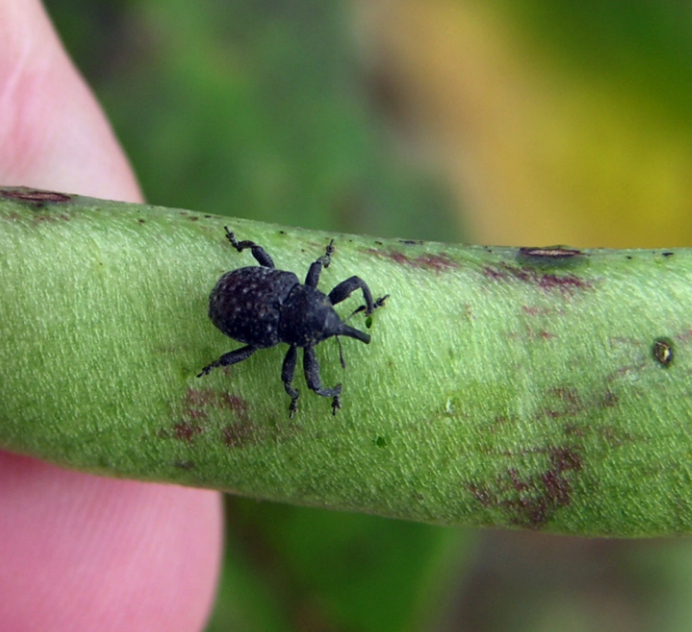Chalcodermus aeneus (Boheman)
Author: David Riley, Stormy Sparks, and Sydni Barwick, University of Georgia, 2019
Description
Immature stages: Females lay eggs, which are white, oval in shape, and are less than a centimeter in length, into pods. These consequently hatch into small white grubs that damage the seed (middle image). The duration of the egg stage is three to six days. The duration of the four larval instars of the grub is between six to nine days under summer conditions. The grub has been observed to remain in the pod to feed and develop for up to twenty-seven days under cooler conditions. The grubs eat their way out of the pod, drop to the ground and dig into the soil several inches before it pupates for a couple of weeks. Adults emerge after 1-2 weeks in the summer to several months in the winter.
Adult stages: Cowpea curculio adults are black, oval, robust looking, and about 5 mm in length (top image). Females can lay nearly three-hundred eggs in a forty-five day period.
Biology
Life Cycle: The overwintering stage is the adult which can live for several months in a state of hibernation or diapause. They can be found in the soil or organic debris in the winter, but by April, adults start to appear in snap beans, early planted cowpeas, or in non-baited traps (bottom image). These reproduce mainly in the late spring cowpea crop with adults peaking in May to June and then the second generation peaks in August to September. We have documented that reduced egg lay occurs in September and later, likely due to weevils going into diapause to prepare for overwintering.
Seasonal Distribution: There are two distinct generations of the curculio in Georgia, but a December peak in adult activity has been observed in some years, so a third generation is not ruled out.
Damage
The damage to cowpea (also known as blackeyed pea or southern pea) in primarily to the pod and seed production (middle image). Severe damage can result in a complete loss of flowers and pods and typically an increase in vegetative vine growth. Grubs present in harvested seed also present a contamination problem.
Management
The cowpea curculio can be challenging to monitor because they feign death, making scouting practices difficult. Another challenge is that unfortunately, the cowpea curculio has become tolerant to pyrethroid insecticides which was the primary means of control during the flowering stage of the crop. Planting the crop for a late September pod set can avoid some damage.

